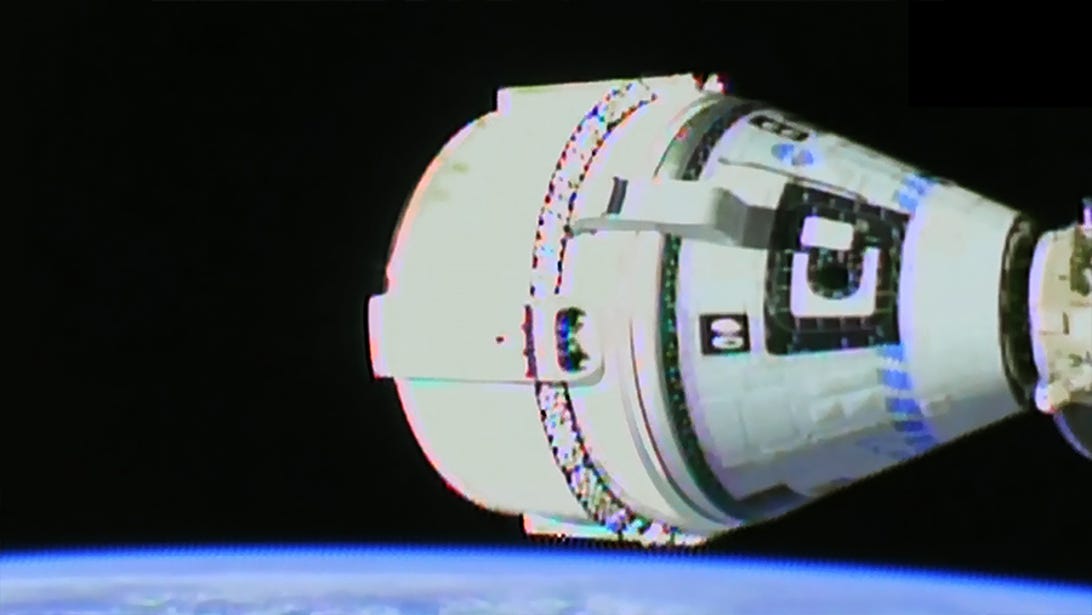It took a little extra time for Boeing’s uncrewed Starliner capsule to dock with the International Space Station for the first time, with NASA mission control announcing the spacecraft officially docked with the ISS at 5:28 PT on Friday.
The milestone came a little over an hour later than initially expected and more than two years since Starliner’s last attempt to reach the orbiting laboratory.
The astronauts living on the station will open the hatch to Starliner on Saturday and unload the shipment of food and other cargo inside. The capsule is set to spend several days attached to the ISS before returning to Earth.


Starliner seen docked to the ISS Friday.
NASA TVThe capsule launched atop a United Launch Alliance Atlas V rocket at 3:54 p.m. PT Thursday from Cape Canaveral Space Force Station in Florida.
The mission is referred to as Orbital Flight Test-2 (OFT-2) because Starliner’s first attempt at an OFT in 2019 saw the conical craft fail to reach the ISS due to a software glitch. The vehicle did manage to land back on Earth, but a NASA safety advisory panel later revealed that a second software problem was corrected in midflight that had “the potential for catastrophic spacecraft failure.”
Starliner’s problems continued after Boeing worked to address 80 recommendations NASA made following an investigation of what happened during the first OFT. It rolled Starliner out to the launch pad in August of last year, but technical problems scrubbed the launch, and the vehicle had to be pulled back inside for inspection. A problem with some valves set the test back for several more months until finally lifting off Thursday.
“Through adversity, our teams have continued to innovate for the benefit of our nation and all of humanity,” NASA Administrator Bill Nelson said in a statement after the launch. “I look forward to a successful end-to-end test of the Starliner spacecraft, which will help enable missions with astronauts aboard.”
NASA has sunk over $4 billion into Starliner via its Commercial Crew program. It’s one of two commercial vehicles the agency chose to eventually shuttle astronauts to the ISS. The other was SpaceX’s Crew Dragon, which has already sent four batches of astronauts to the space station.
Aside from the big chunk of taxpayer dollars already invested in the spacecraft, it’s in NASA’s interest for Boeing to succeed for another reason. It could use another option for sending astronauts to and from space, to avoid the imperfect place it found itself after the space shuttle was retired in 2011.
For the following nine years, Russian Soyuz capsules were the only ride to and from orbit. That was until SpaceX sent two astronauts to the ISS for the first time aboard a Crew Dragon in 2020. Elon Musk’s company managed this feat nearly two years ago after being awarded a Commercial Crew contract from NASA at the same time as Boeing, and for over $1 billion less.
It’s unclear how far off Boeing’s first attempt at a crewed demonstration mission might be.
Until the time NASA greenlights Boeing for crewed astronaut missions, the agency’s only two options for sending humans to orbit are SpaceX and Russia’s Soyuz. But relations with Russia’s space agency, Roscosmos, are strained at the moment following Russia’s invasion of Ukraine and international sanctions against Russia.
Roscosmos head Dmitry Rogozin has made bizarre threats, alluding to blocking cooperation on the ISS and even sending it into an “uncontrolled deorbit and fall into the United States or Europe.”
So it would clearly be nice for NASA to have two US-based companies for its astronauts to hitch rides with.
